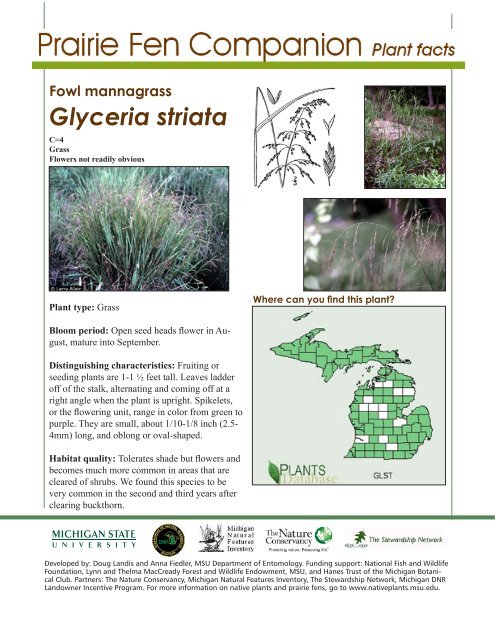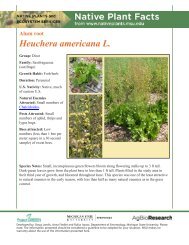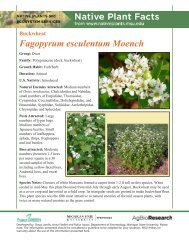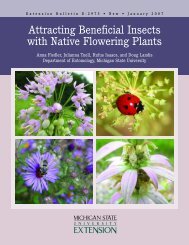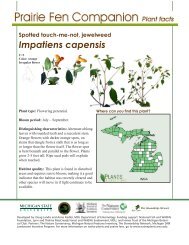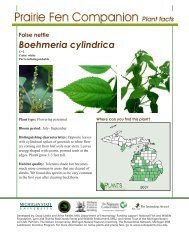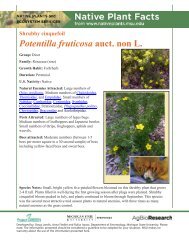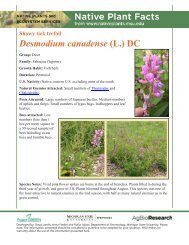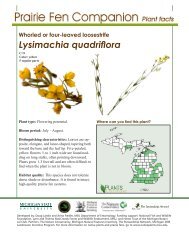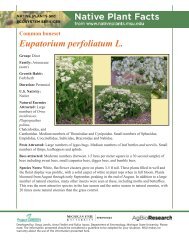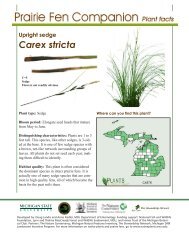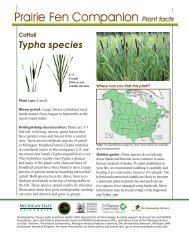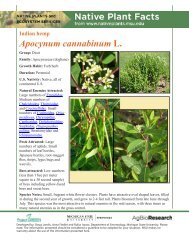Fowl mannagrass - Native Plants - Michigan State University
Fowl mannagrass - Native Plants - Michigan State University
Fowl mannagrass - Native Plants - Michigan State University
You also want an ePaper? Increase the reach of your titles
YUMPU automatically turns print PDFs into web optimized ePapers that Google loves.
<strong>Fowl</strong> <strong>mannagrass</strong><br />
Glyceria striata<br />
C=4<br />
Grass<br />
Flowers not readily obvious<br />
Plant type: Grass<br />
Where can you find this plant?<br />
Bloom period: Open seed heads flower in August,<br />
mature into September.<br />
Distinguishing characteristics: Fruiting or<br />
seeding plants are 1-1 ½ feet tall. Leaves ladder<br />
off of the stalk, alternating and coming off at a<br />
right angle when the plant is upright. Spikelets,<br />
or the flowering unit, range in color from green to<br />
purple. They are small, about 1/10-1/8 inch (2.5-<br />
4mm) long, and oblong or oval-shaped.<br />
Habitat quality: Tolerates shade but flowers and<br />
becomes much more common in areas that are<br />
cleared of shrubs. We found this species to be<br />
very common in the second and third years after<br />
clearing buckthorn.<br />
Developed by: Doug Landis and Anna Fiedler, MSU Department of Entomology. Funding support: National Fish and Wildlife<br />
Foundation, Lynn and Thelma MacCready Forest and Wildlife Endowment, MSU, and Hanes Trust of the <strong>Michigan</strong> Botanical<br />
Club. Partners: The Nature Conservancy, <strong>Michigan</strong> Natural Features Inventory, The Stewardship Network, <strong>Michigan</strong> DNR<br />
Landowner Incentive Program. For more information on native plants and prairie fens, go to www.nativeplants.msu.edu.
Where can you find this plant?<br />
Indiana<br />
New York<br />
Ohio<br />
Wisconsin<br />
For more information on native plants and prairie<br />
fens, go to www.nativeplants.msu.edu<br />
MSU is an affirmative-action, equal-opportunity employer. <strong>Michigan</strong> <strong>State</strong> <strong>University</strong> Extension programs and materials are open to all without regard to race, color, national origin,<br />
gender, gender identity, religion, age, height, weight, disability, political beliefs, sexual orientation, marital status, family status or veteran status. Issued in furtherance of MSU Extension<br />
work, acts of May 8 and June 30, 1914, in cooperation with the U.S. Department of Agriculture. Thomas G. Coon, Director, MSU Extension, East Lansing,MI 48824. This information is for<br />
educational purposes only. Reference to commercial products or trade names does not imply endorsement by MSU Extension or bias against those not mentioned.
Key description<br />
C=<br />
Coefficient of conservatism. This is a value that ranges from 0 for non-native invasives to 10 for<br />
plants that would only be expected to be found in undisturbed, high quality plant communities. It is a<br />
general guideline for whether the plant would be likely to be found in an intact prairie fen (not filled<br />
in with shrubs and without invasive species). However, C values may be high for some species that<br />
are not found in prairie fen but would be part of another wetland such as a marsh. They are included<br />
here because they are a widely accepted measure of habitat quality in the Midwest (http://1.usa.gov/<br />
FQAMethod).<br />
Flower type<br />
Classifications here follow those of Newcomb’s wildflower guide (http://amzn.com/0316604429).<br />
Number of regular parts<br />
The flower has this number of petals or petal-like parts that are symmetrical from<br />
the flower center (radial), with each similar to the other in shape, size, and color.<br />
There may be 3 to 7 regular parts. See image at right.<br />
Aster<br />
These flowers have regular parts and are symmetrical from the center, but there are<br />
more than 7. Asters have a set of disc flowers in the center of the flower and a set<br />
of ray flowers outside of the disc flowers, often called petals. They are one group<br />
(genus) within the family Asteraceae, and there are many species in this genus.<br />
Flowers not readily obvious<br />
The flowers of plants such as grasses, sedges, and cattail are not obvious and are often confused with<br />
the fruits (seeds) of these species. While this website does not include flower descriptions for these<br />
species, they do flower.<br />
Irregular<br />
The flower is not symmetrical from the center but is symmetrical down a line<br />
(bilateral). See image at right.<br />
No flowers<br />
A number of primitive plants, including ferns, do not flower but make spores in<br />
order to reproduce.<br />
Parts indistinguishable<br />
These species either have parts so small their number is difficult to determine or have no petal-like<br />
parts. This group includes goldenrods, other species with small individual flowers, and plants in the<br />
family Asteraceae that have more than 7 parts, but the parts do not form distinguishable, symmetrical<br />
ray flowers (which are often called petals).<br />
MSU is an affirmative-action, equal-opportunity employer. <strong>Michigan</strong> <strong>State</strong> <strong>University</strong> Extension programs and materials are open to all without regard to race, color, national origin,<br />
gender, gender identity, religion, age, height, weight, disability, political beliefs, sexual orientation, marital status, family status or veteran status. Issued in furtherance of MSU Extension<br />
work, acts of May 8 and June 30, 1914, in cooperation with the U.S. Department of Agriculture. Thomas G. Coon, Director, MSU Extension, East Lansing,MI 48824. This information is for<br />
educational purposes only. Reference to commercial products or trade names does not imply endorsement by MSU Extension or bias against those not mentioned.


